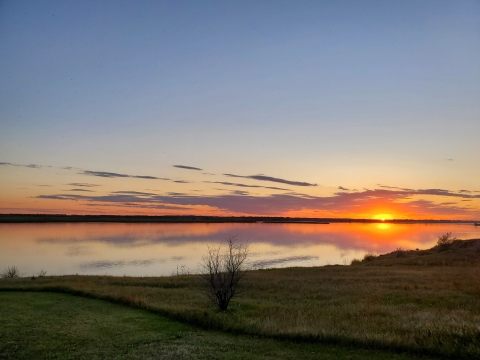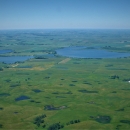About Us
"Wild beasts and birds are by right not the property merely of the people who are alive today, but the property of unknown generations whose belongings we have no right to squander."
-Theodore Roosevelt
Long Lake National Wildlife Refuge was once home to Plains Indians and early European settlers who camped and hunted waterfowl and other game along the shores of Long Lake. The Refuge was established on February 25, 1932 by President Herbert Hoover to provide sanctuary and habitat for migratory birds that use the Central Flyway migration corridor.
Staff at Long Lake National Wildlife Refuge oversee management of two satellite refuges - Slade National Wildlife Refuge and Florence Lake National Wildlife Refuge- as well as a three-county wetland management district wetland management district
A wetland management district is a U.S. Fish and Wildlife Service office that manages waterfowl production areas in one or more counties. Waterfowl production areas are small natural wetlands and grasslands that provide breeding, resting and nesting habitat for waterfowl, shorebirds, grassland birds and other wildlife. The Fish and Wildlife Service acquires waterfowl production areas under the authority of the Migratory Bird Hunting and Conservation Stamp Act, primarily using funds from the sale of Federal Duck Stamps. The Refuge System’s 38 wetland management districts comprise thousands of waterfowl production areas – almost all in the Prairie Pothole Region of the Northern Great Plains.
Learn more about wetland management district . Long Lake NWR is located in south-central North Dakota, near the town of Moffit, in an area famous for its wealth of waterfowl producing prairie potholes. Long Lake is two miles wide, 18 miles long, and has been separated into three units using dikes and spillways to manage water levels and control avian botulism disease outbreaks that have historically occurred. Water levels in the lake are highly variable depending on inflows from Long Lake Creek located south of the Refuge. The result is a highly dynamic system. During wet periods, the lake has depths of four to six feet for successive years providing for an excellent fishery.
As water levels recede, exposed mud flats provide a mecca for waterfowl, shorebirds, and other rare water birds including the endangered whooping crane. Beyond the lake, smaller scattered seasonal wetlands and pools are interspersed in mixed grass prairie, ravines, tree and shrub plantings, and cultivated fields.
Long Lake National Wildlife Refuge was listed as a top 10 birding site by Wild Bird Magazine. The Refuge was also designated as both a Globally Important Bird Area (https://www.audubon.org/important-bird-areas) and a Western Hemisphere Shorebird Reserve Network site (https://whsrn.org/whsrn-sites/map-of-sites/) because of its importance as both a breeding and migratory stopover site for more than 20,000 shorebirds, annually.
Our Mission
Each unit of the National Wildlife Refuge System is established to serve a statutory purpose that targets the conservation of native species dependent on its lands and waters. All activities on those acres are reviewed for compatibility with this statutory purpose.
Long Lake National Wildlife Refuge was established through Executive Order No. 5808 “… as a refuge and breeding ground for migratory birds and wild animals,” and “…for use as an inviolate sanctuary, or for any other management purpose, for migratory birds.” (Migratory Bird Conservation Act.)
The goals of the Long Lake National Wildlife Refuge are focused on 6 priorities: wildlife and habitat management, research, public use, cultural resources, refuge operations, and partnerships.
In wildlife and habitat management, we aim to conserve, restore, and enhance the ecological diversity of the mixed-grass prairie ecosystem for migratory birds with an emphasis on waterfowl and other grassland and wetland-dependent species. Through applied research, inventory, and monitoring, we use sound science to advance the understanding of natural resource functions and management within the prairie pothole ecosystem.
Through public use, education, and interpretation, we strive to provide a safe environment for visitors to enjoy wildlife-compatible recreation while increasing their knowledge and appreciation of the mixed-grass prairie ecosystem and the mission of the National Wildlife Refuge System.
Refuge operations are conducted through effective communication and innovative technology, efficient use of funding, staffing, partnerships, and volunteer programs for the benefit of natural resources. We hope to engage a wide array of partners to support outreach, research, and management, promote awareness, and foster an appreciation of the mixed-grass prairie pothole ecosystem.
Our History
During the 1930’s, the Works Progress Administration and Civilian Conservation Corps were born out of circumstances brought on by economic depression. The programs were authorized in 1933 to bring hope, relief, and meaningful employment to millions of young men.
At Long Lake National Wildlife Refuge, the Civilian Conservation Corp, comprised largely of local residents, played an important role in the development of the Refuge. Participants worked primarily on water development, wildlife conservation, and erosion control. Trucks and teams of men and horses moved rock and gravel to construct dikes and build small check dams in ravines, creating ponds for wildlife. Nineteen islands were constructed for duck nesting in Units I and II of the lake. An office/shop building, residence, and other related structures were also built in the 1930's using native field stone.
Prior to the creation of Long Lake National Wildlife Refuge and during the Refuge’s early years, avian botulism was a major issue. For many years, avian botulism killed up to 250,000 birds (primarily ducks) annually. The disease is caused by a bacterial toxin that attacks a bird's central nervous system. Combined spring run-off and rainfall is not always high enough to establish and maintain desirable water levels. The two dikes that were built by the Works Progress Administration divide Long Lake into three water management units. The dikes and water control structures have increased water management capabilities on the Refuge. Through manipulation of water levels, the incidence and severity of avian botulism outbreaks have been reduced.





